Becker W. Advanced Time-Correlated Single Photon Counting Techniques
Подождите немного. Документ загружается.

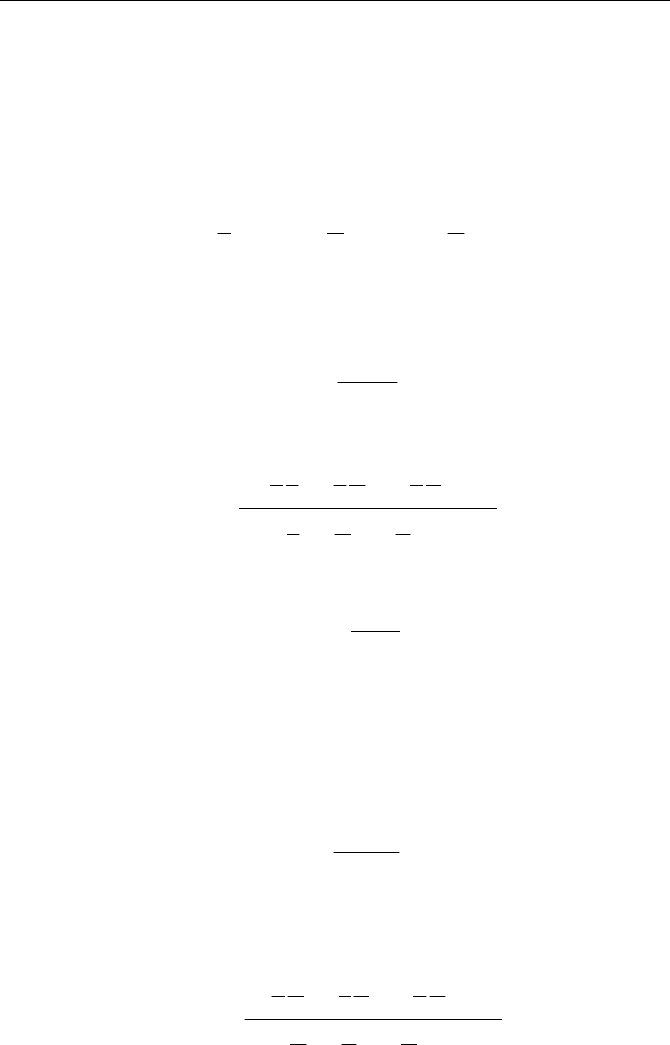
7.9 Counting Loss in TCSPC Systems 335
The probability of
recording a photon in channel j is the product of the probability
of detecting a photon in channel j and the probability of detecting no photons in
the channels 0 to
j1:
WW
W
//
/
1
tjPePt
jrecorded
eeeePP
tj
''
'
(7.20)
The first factor is independent of
j. The second factor is the waveform of the re-
corded signal. The waveform can be written as
...
!2
1
!2
1
!1
1
)(
/43/32/2/
''''
WWWW
tjtjtjtj
ePePPeejf (7.21)
That means that the pile-up adds virtual lifetime components of
W
/2,
W
/3 ...
W
/n, to
the recorded waveform. A mean lifetime,
W
meanc
, of the recorded curve can be de-
fined as an average of the lifetimes,
W
i
weighted by their intensity coefficients, a
i
:
¦
¦
i
ii
meanc
a
a
W
W
(7.22)
The resulting
W
meanc
is
.....
!3
1
!2
1
!1
1
1
...
!3
1
4!2
1
3!1
1
2
32
32
PPP
PPP
meanc
WWW
W
W
(7.23)
which can be converted into
P
P
meanc
eP
e
1
WW
(7.24)
For a small value of
P the obtained mean lifetime is
2/1 p
meanc
|
WW
(7.25)
The definition used for
W
meanc
leads to a simple expression of the measured lifetime.
It is, however, not the only possible one. The lifetimes can also be weighted by the
integral intensities of the exponential components:
ii
ii
meani
a
a
W
W
W
¦
2
(7.26)
The intensity-weighted mean lifetime is a better approximation of the lifetime
obtained by a single-exponential fit or by calculations based on the first moments
[308]. The pile-up distorted
W
meani
is
.....
!4
1
!3
1
!2
1
1
...
!4
1
4
1
!3
1
3
1
!2
1
2
1
1
32
32
PPP
PPP
meani
WW
(7.27)
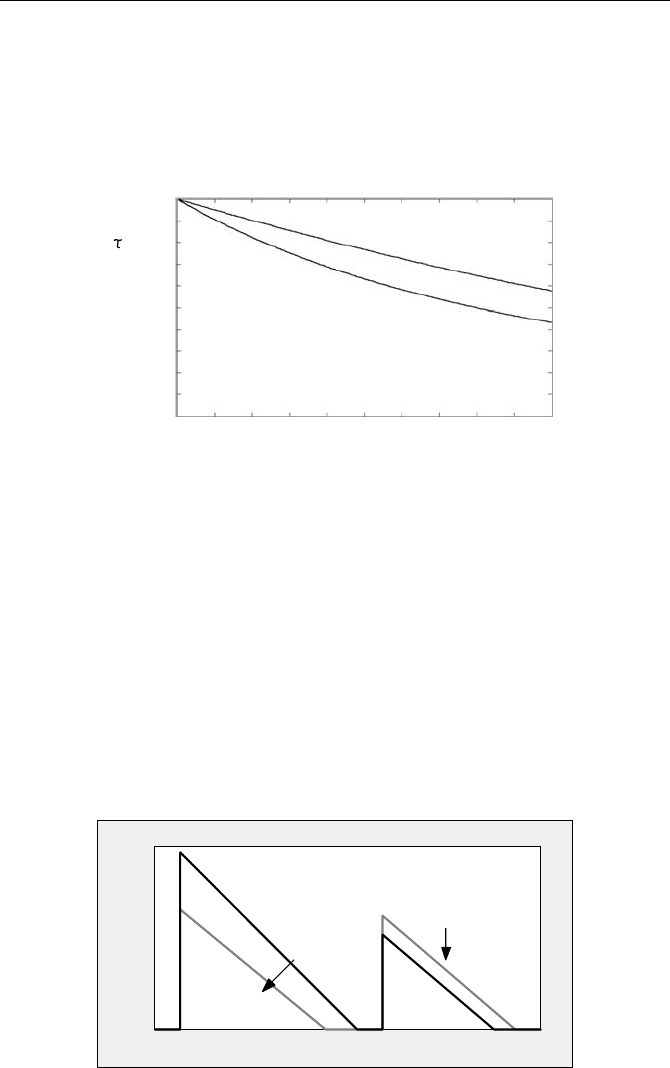
336 7 Practice of TCSPC Experiments
Unfortunately the intensity-weighted mean lifetime does not yield a simple re-
sult for the pile-up. For a small value of
P the lifetime is
4/P1|
WW
meani
(7.28)
Figure 7.78 shows the recorded coefficient-weighted and intensity-weighted
mean lifetime as a function of the number of photons per laser period,
P.
0.2 0.4 0.6 0.8 1.0 1.2 1.61.4 1.8 2
Number of Photons per Signal Period, P
Relative
1.0
0.1
0.2
0.3
0.4
0.5
0.6
0.7
0.8
0.9
b
a
Fig. 7.78 Coefficient-weighted mean lifetime (a) and intensity-weighted lifetime (b) as a
function of the number of photons detected per signal period, P
The influence of the pile-up on the obtained lifetimes is surprisingly small. A
5% change in the intensity-weighted mean lifetime is often tolerable. The corre-
sponding P is about 0.2, i.e. the detector count rate is 20% of the pulse repetition
rate. With pile-up correction, even higher count rates appear possible. Pile-up is
therefore not a severe problem at pulse repetition rates between 50 to 90 MHz,
typical for titanium-sapphire lasers and diode lasers.
A remark should be made here about multiplexing signals on a pulse-by-pulse
basis. The principle is shown in Fig. 7.79. Several signals, signal 1 and signal 2,
are offset in time and recorded in the same TAC range with a common stop pulse.
At low intensity (curve A), the pile-up is negligible and both signals are recorded
with their correct shape and intensity. If the intensity of signal 1 is increased into
log
counts
channels
Signal 1 Signal 2
pileup
pileup from
AA
B
B
signal 1
Fig. 7.79 Effect of classic pile-up on signals recorded with pulse-by-pulse multiplexing
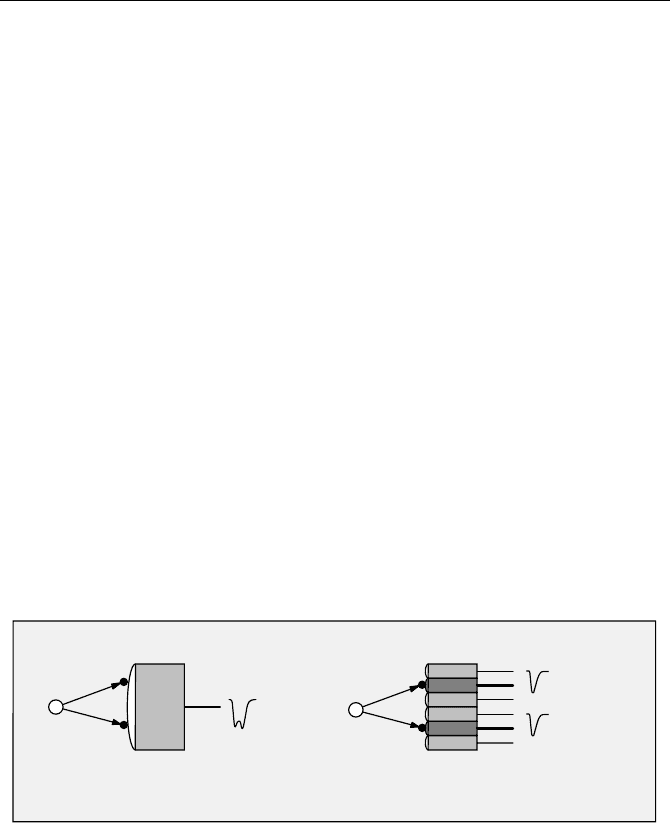
7.9 Counting Loss in TCSPC Systems 337
the pile-up region (curve B), the shape of signal 1 is distorted. Signal 2 is recorded
with its correct shape but with an incorrect amplitude.
In the general case, each signal gets changed in shape only by its own pile-up.
However, it gets changed in amplitude by the pile-up of all earlier signals. Mutual
pile-up effects between multiplexed signals can be entirely avoided by using the
multiplexing features of advanced TCSPC (see Sect. 3.2, page 33, and Sect. 5.5.8,
page 117).
Several solutions have been suggested to detect pile-up and to reject the re-
cording of multiphoton events [389]. However, for the most commonly used de-
tectors, it is difficult if not impossible to distinguish between one and two photons
arriving within the width of the single-electron response of the detector (Fig. 7.80,
left). Multiphoton events at a time scale of 10 to 20 ns could, in principle, be de-
tected by counting the number of CFD threshold transitions within one signal
period. However, in practice the single-electron-response of the detector is not
free of ringing and reflections. Therefore single-photon pulses near the upper end
of the SER amplitude distribution cause multiple threshold transitions as well.
Discarding all events with multiple threshold transitions would result in losing a
large number of good photon pulses.
Nevertheless, there is a way to reduce the classic pile-up. The light is distrib-
uted into several detectors, or into several channels of a multianode PMT. Two
photons arriving within the same signal period are then more likely to hit different
detectors than the same one (Fig. 7.80, right). Pulses that appear at the outputs of
different detectors can easily be identified as multiphoton events. The recording of
both photons in the TCSPC module can be suppressed and pile-up distortion can
be avoided.
Photon 1
Photon 2
Photon 1
Photon 2
Single detector:
Photons not distingushed
Multichannel detector:
Photons distinguished
Fig. 7.80 Multidetector operation reduces pile-up by recognising multiphoton events
The required circuitry is contained in any router for multidetector TCSPC (see
Sect. 3.1, page 29). The router monitors the output signal of all detector channels
by fast discriminators. When a detector delivers a photon pulse the corresponding
discriminator triggers and an encoder generates a digital „detector channel“ num-
ber (Fig. 3.3, page 30). If several detectors deliver pulses within the response time
of the discriminator/encoder circuitry, the encoder delivers a „Disable Count“
signal. This signal suppresses the storing of the event, i.e. of both photons, in the
memory of the TCSPC module. Thus, waveform distortion by classic pile-up is

338 7 Practice of TCSPC Experiments
reduced. The time interval in which several photons are recognised as a mul-
tiphoton event is usually of the order of several tens of ns.
An even more efficient, yet more expensive way to reduce pile-up distortion is
the multimodule technique. In a multimodule system the photons from several
detectors are processed in parallel. Therefore, not only pile-up distortion but also
counting loss are reduced in proportion to the number of TCSPC channels.
7.9.2 Counting Loss
Due to the finite speed of signal processing, a photon counter is unable to detect a
second photon within a certain dead time after the detection of a previous one. For
gated photon counters or multichannel scalers, the dead time can be as short as a
nanosecond. The relatively complicated signal processing sequence in a TCSPC
device leads to a much longer dead time. Older TCSPC devices had dead times of
the order of 10 µs. Newer, more advanced TCSPC modules are much faster but
still have a dead time in the range of 100 to 150 ns.
The probability of losing a photon can be calculated as follows. The photons
are detected at a rate
r
det
, and recorded at a rate, r
rec
. Each recorded photon causes a
dead time,
t
d
. If another photon is detected within this time it is lost, but it does not
cause a noticeable dead time. The fraction of the total dead time,
T
dead
, within the
total acquisition time,
T, is therefore
drecdead
trTT / (7.29)
The ratio of the number of photons lost in the dead time to the number of
de-
tected
photons is the same as the ratio of the total dead time to the total acquisition
time:
dreclost
trNN
det
/ (7.30)
The recorded rate is
drecrec
trrrr
detdet
or
d
rec
tr
r
r
det
det
1
(7.31)
Please note that this equation applies strictly only to systems in which the lost
photons do not cause any appreciable dead time. If the lost photons cause dead
time, the equation applies only for count rates that are small compared to the re-
ciprocal dead time. The relation between the input count rate and the recorded
count rate is shown in Fig. 7.81.
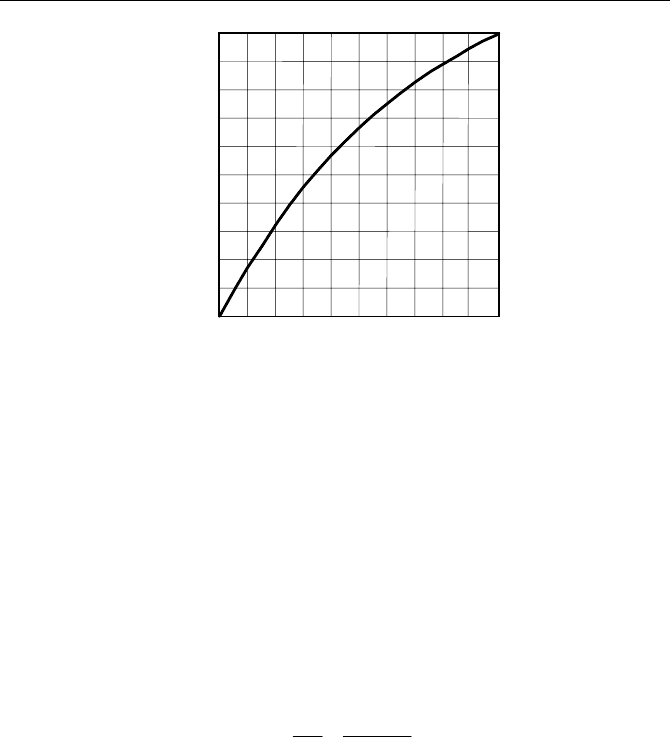
7.9 Counting Loss in TCSPC Systems 339
0.1 0.2 0.4 0.5 0.6 0.7 0.8 0.90.3
0.1
0.2
0.3
0.4
0.5
Detector Count Rate, in units of reciprocal dead time
Rate
Recorded
Count
1/td
1/td
Fig. 7.81 Relation between the input count rate and the recorded count rate for a photon
counter with the dead time, t
d
, for a continuous light signal
For an input count rate 1/t
d
, i.e. the reciprocal of the dead time, the recorded
count rate is 50% of the input count rate. The recorded count rate for a 50% count-
ing loss is sometimes defined as the „maximum useful count rate“,
r
mu
:
dmu
tr /5.0 (7.32)
Data sheets of TCSPC devices sometimes specify a „maximum count rate“ that
is simply the reciprocal signal processing time. This definition is misleading be-
cause for random input pulses it can be reached only for an infinite detector count
rate. The term „saturated count rate“ should better be used instead of „maximum
count rate“.
Equation(7.31) can be used to calculate the counting efficiency, E:
d
rec
trr
r
E
detdet
1
1
(7.33)
with
r
det
= detected count rate, r
rec =
recorded at a rate, t
d =
dead time.
For the discussion above it was assumed that the detected light signal was con-
tinuous. However, signals measured by TCSPC are mostly pulsed signals. More-
over, the detection and therefore the dead time is synchronised with the signal
period. This synchronisation can lead to a different behaviour than predicted by
(7.33). Dead-time-related counting loss in nonreversed start-stop systems is illus-
trated in Fig. 7.82.

340 7 Practice of TCSPC Experiments
start-
Photon
dead time
ends here
time
system is blind system is active
TAC / ADC
dead time
Laser
Fluorescence
signal
Start
pulse
Start
pulse
Start
pulse
stop
start-
Photon
dead time
ends here
time
system is blind
system is
system is blind
TAC / ADC
dead time
active
Laser
Fluorescence
signal
Start
pulse
Start
pulse
Start
pulse
stop
Fig. 7.82 Dead-time-related counting loss in a nonreversed start-stop system. Left: Signal
period longer than dead time. Right: Signal period shorter than dead time
In nonreversed start-stop systems the TAC is started with the laser pulse. When
a photon is detected, the TAC is stopped and the signal processing starts. Signal
processing takes some time, here indicated as „TAC/ADC dead time“. After the
processing is completed the TAC does not convert another photon pulse until it
has received the next start pulse from the laser. For the counting loss, two cases
have to be distinguished:
If the signal period is longer than the sum of the start-stop time and the
TAC/ADC dead time (Fig. 7.82, left) the dead time ends before the next laser
pulse. If a second photon is detected during this signal period it is lost. Conse-
quently, the situation is exactly described by the classic pile-up effect.
If the signal period is shorter than the sum of the start-stop time and the
TAC/ADC dead time the situation is different (Fig. 7.82, right). Of course, if a
second photon is detected in the same signal period, the system loses it. This is the
classic pile-up effect. However, because the dead time extends into the next signal
period, the TAC does not start with the next laser pulse. Consequently, the system
remains blind for the next signal period as well.
Several signal periods can be lost if the TAC/ADC dead time extends over
more than one period. Even worse, the necessary reset of the TAC causes a dead
time even if no photon was detected. If this reset time extends into the next period
the counting efficiency drops to 50% or less.
Figure 7.83 illustrates the situation for reversed start-stop systems and low-
repetition-rate signals. In the reversed start-stop configuration the TAC is started
when a photon is detected. In a correctly designed system the stop pulse of the
TAC comes from the delayed laser pulse. The stop delay is somewhat longer than
the time interval to be recorded. Data processing starts when the stop, i.e. the de-
layed laser pulse, arrives at the TAC. The system is now blind for the TAC/ADC
dead time. However, the pulse period is longer than the sum of the stop delay and
the TAC/ADC dead time. Therefore the TAC/ADC dead time is entirely outside
time interval in which the signal is recorded. Consequently, the only way the sys-
tem may lose photons is through classic pile-up.
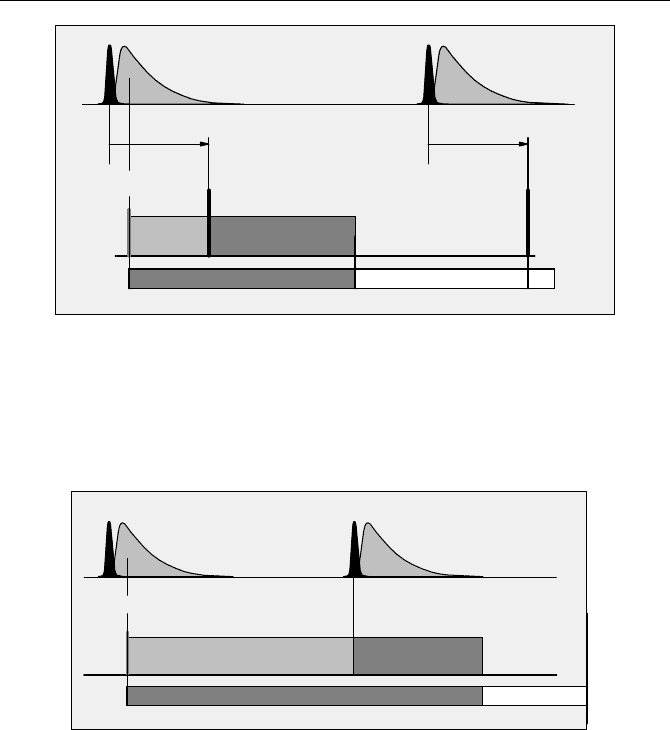
7.9 Counting Loss in TCSPC Systems 341
start-stop
TAC / ADC
Photon dead time
ends here
dead timetime
ref. pulse
System is blind System is active
Delayed
ref. pulse
Delayed
Stop delay Stop delay
Fig. 7.83 Dead-time-related counting loss in a reversed start-stop system. The stop is with a
delayed laser pulse. The signal period is longer than the sum of the stop delay and the
TAC/ADC dead time
Figure 7.84 shows what happens if a reversed start-stop system is operated at
low repetition rate without a delay line in the stop line of the TAC.
start-stop
TAC / ADC
Photon
dead time
ends here
dead timetime
System is blind System is active
Fig. 7.84 Dead-time-related counting loss in a reversed start-stop system. The signal period
is longer than the dead time; the stop is with the next laser pulse
The TAC is started when a photon is detected. It is, however, not stopped with
the delayed laser pulse that produced this photon, but with the next one. The signal
processing starts with this pulse. The TAC/ADC dead time turns the system blind
for a large part of the next laser period. The blind interval of the next period is in
fact the interval where a new signal photon is most likely to be expected. Conse-
quently, the system can be considered to be blind for the next signal period after
the detection of a photon. The probability of losing a photon in the blind period is
repreclose
f
r
p
/
(7.34)
with
r
rec
= recorded count rate, f
rep
= signal repetition rate.
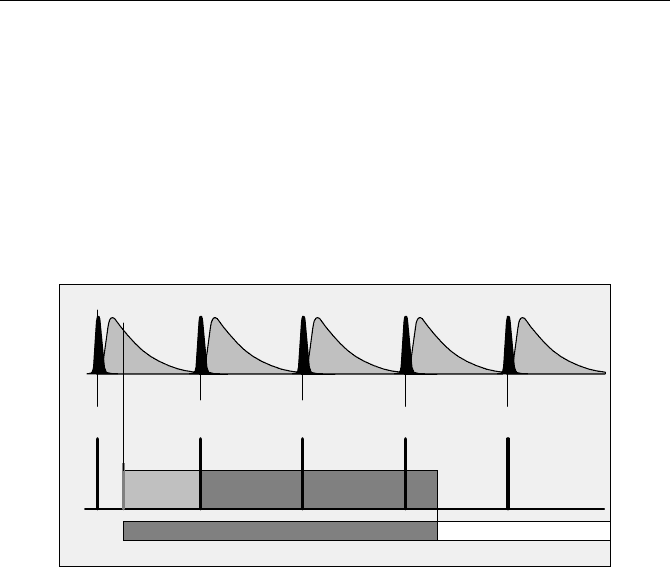
342 7 Practice of TCSPC Experiments
The relation between the detector count rate
r
det
and recorded count rate r
rec
(classic pile-up not included) is
)1(/
detdet
Trrr
rec
(7.35)
with
T = signal period. In other words, the system has an effective dead time of
one signal period.
The situation for reversed start-stop and high repetition rate signals is shown in
Fig. 7.85. The TAC is started when a photon is detected and stopped with the next
laser pulse. Within the time between the start and the stop, the TAC is unable to
record a second photon. The resulting loss is the classic pile-up effect.
start-stop
TAC / ADC
Photon
Stop
dead time
ends here
dead time
time
System is blind System is active
Pulse Pulse Pulse Pulse
Laser
Fluorescence
signal
Stop Stop Stop
Pulse
Stop
Fig. 7.85 Dead-time-related counting loss in a reversed start-stop system. The signal period
is shorter than the dead time. The stop is with the next laser pulse.
Signal processing starts with the stop, i.e. with the next laser pulse. During the
signal processing time (or TAC/ADC dead time) the system is blind. The
TAC/ADC dead time ends somewhere in one of the subsequent signal periods.
How many photons the system loses depends on the number of signal periods
within the TAC/ADC dead time, and to a smaller degree on the distribution of the
detection probability within the signal period where the dead time ends. The effec-
tive dead time of the system is the TAC/ADC dead time plus the average start-stop
time. For a continuous signal the relation between detected and recorded rate is
given in equation (7.33). For a pulsed signal, the counting loss changes in discrete
steps with the number of signal periods within the dead time. However, it follows
the general tendency of (7.33).
Counting loss in reversed start-stop systems operated at high signal repetition
rate can be compensated for by a „dead time compensation“ in the acquisition
time. The idea behind the dead time compensation is to increase the acquisition
time by the sum of all dead time intervals that occurred during the measurement.
The principle is shown in Fig. 7.86.
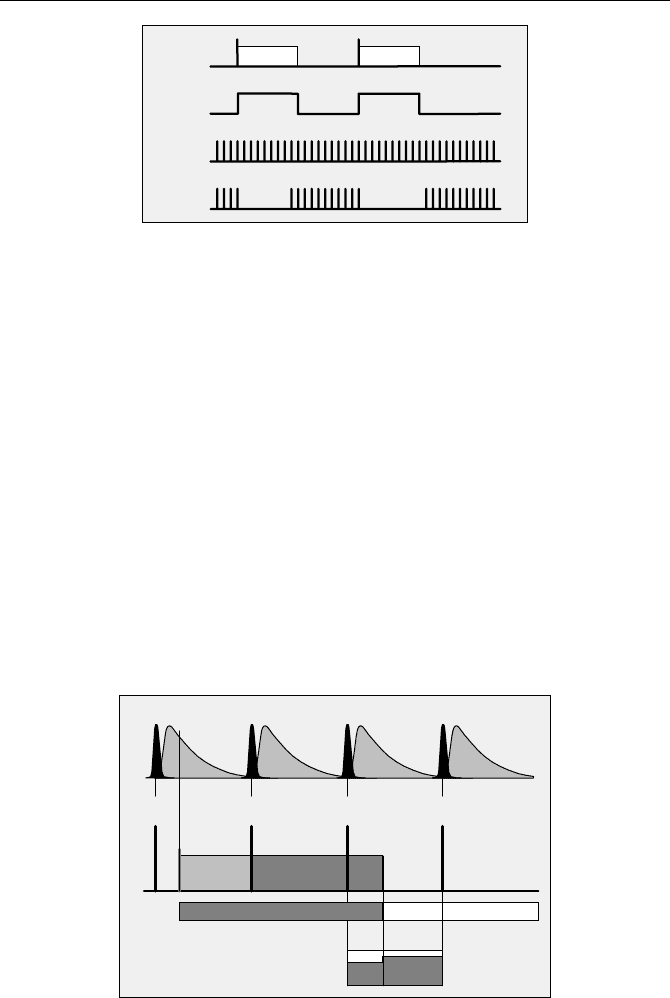
7.9 Counting Loss in TCSPC Systems 343
Photons
TAC
busy
Clock
Generator
Timer
Clock
deadtime deadtime
Fig. 7.86 Dead time compensation by gating the timer clock
The TAC delivers a „busy“ signal as long as it is unable to accept a new pho-
ton, i.e. from the start of the TAC to the end of the TAC/ADC dead time. A high-
frequency clock is gated with the busy signal, and the gated clock drives the col-
lection timer. Thus the collection timer is stopped in the dead time intervals.
Of course, dead-time compensation works with absolute precision only if the
photons appear randomly. Unfortunately in most TCSPC applications, the signal
is pulsed and most of the photons are detected in only a small fraction of the signal
period. Nevertheless, the compensation works well for repetition rates higher than
the reciprocal dead time. It can, however, correct for only the loss in the recorded
intensity, not for distortion in the recorded pulse shape.
7.9.3 Dead-Time-Related Signal Distortion
For TCSPC with nonreversed start-stop, the end of the dead-time interval is auto-
matically synchronised with the laser pulses. For reversed start-stop this in not the
case. The situation is shown in Fig. 7.87.
start-stop
TAC / ADC
Photon
Stop
dead time
ends here
Average detection probability
dead timetime
System is blind System is active
Pulse Pulse Pulse Pulse
Laser
Fluorescence
signal
Stop Stop Stop
Photon
Fig. 7.87 Dead-time-related signal distortion in high-repetition-rate reversed-start-stop
systems. The dead time ends anywhere in one of the subsequent signal periods, which
causes a step in the detection probability

344 7 Practice of TCSPC Experiments
The TAC/ADC dead time starts with the stop of the TAC. The end of the dead
time can be at any time within one of the subsequent signal periods. Averaged
over a large number of periods, the result is a step in the recording probability and
thus in the recorded waveform. The size of the distortion depends on the ratio of
the count rate to the signal repetition rate and can be estimated as follows.
The probability,
P, to detect a photon in a particular laser period is
P = r
det
/ f
rep
(7.36)
with r
det
= detector count rate at CFD input, f
rep
= signal repetition rate. However, a
photon in the early part of the period can be
recorded only if no photon was de-
tected in the signal period a dead-time interval before. The probability,
p
early
,of
detecting a photon in the early part of the period is therefore
¸
¸
¹
·
¨
¨
©
§
reprep
early
f
r
f
r
p
detdet
1 (7.37)
The relative size of the distortion is
(p
late
– p
early
) / p
late
= r
det
/ f
rep
(7.38)
Interestingly, the size of the dead-time-related distortion does not depend on the
dead time. The absolute size of the distortion is of the same order as the distortion
by classic pile-up. It even counteracts the classic pile-up because it happens in the
early part of the signal period. Although the size of the distortion is predictable,
the actual shape of the distortion is not. It may differ from a clean step because the
dead time may vary due the TAC voltage of the detected photon, and the transition
from the blind into the active state may cause some ripple in the TAC characteris-
tic for a few ns. Moreover, in practice the dead time is determined by CMOS logic
circuits and active delay lines in the control circuitry of the signal processing elec-
tronics. The dead time can therefore be expected to be stable within only a few ns
at best, and it is difficult to correct for dead-time-related distortion.
In practice the distortion can be minimised in the same way as classic pile-up,
i.e. by maximising the signal repetition rate, or, more exactly, maximising the
TAC stop rate. The signal repetition rate should be as high as possible, and the
setup should avoid frequency division in the reference channel and pulse-by-pulse
multiplexing with a common stop pulse (see Sect. 5.5.8, page 117).
A radical cure to avoid pulse distortion by dead-time-related counting loss
would be to synchronise the end of the dead time with the reference pulses. How-
ever, this would result in more mutual influence of start- and stop-related signals
and therefore impair the differential linearity of the time measurement. Extending
the dead time to a full signal period might also be unacceptable for low-repetition
rate experiments.
Some TCSPC modules provide manual control of the dead time so that possible
distortions can be shifted out of the time interval of interest.
